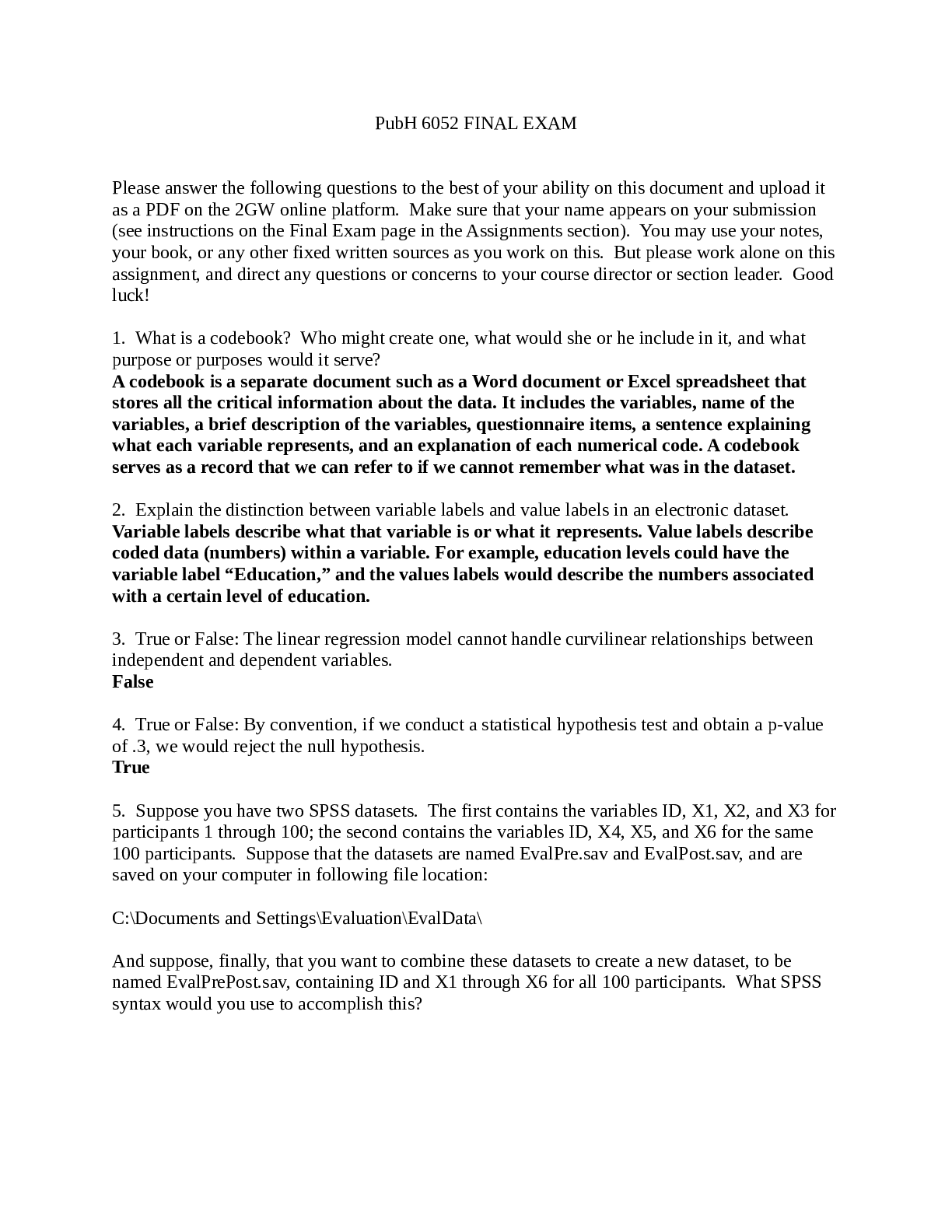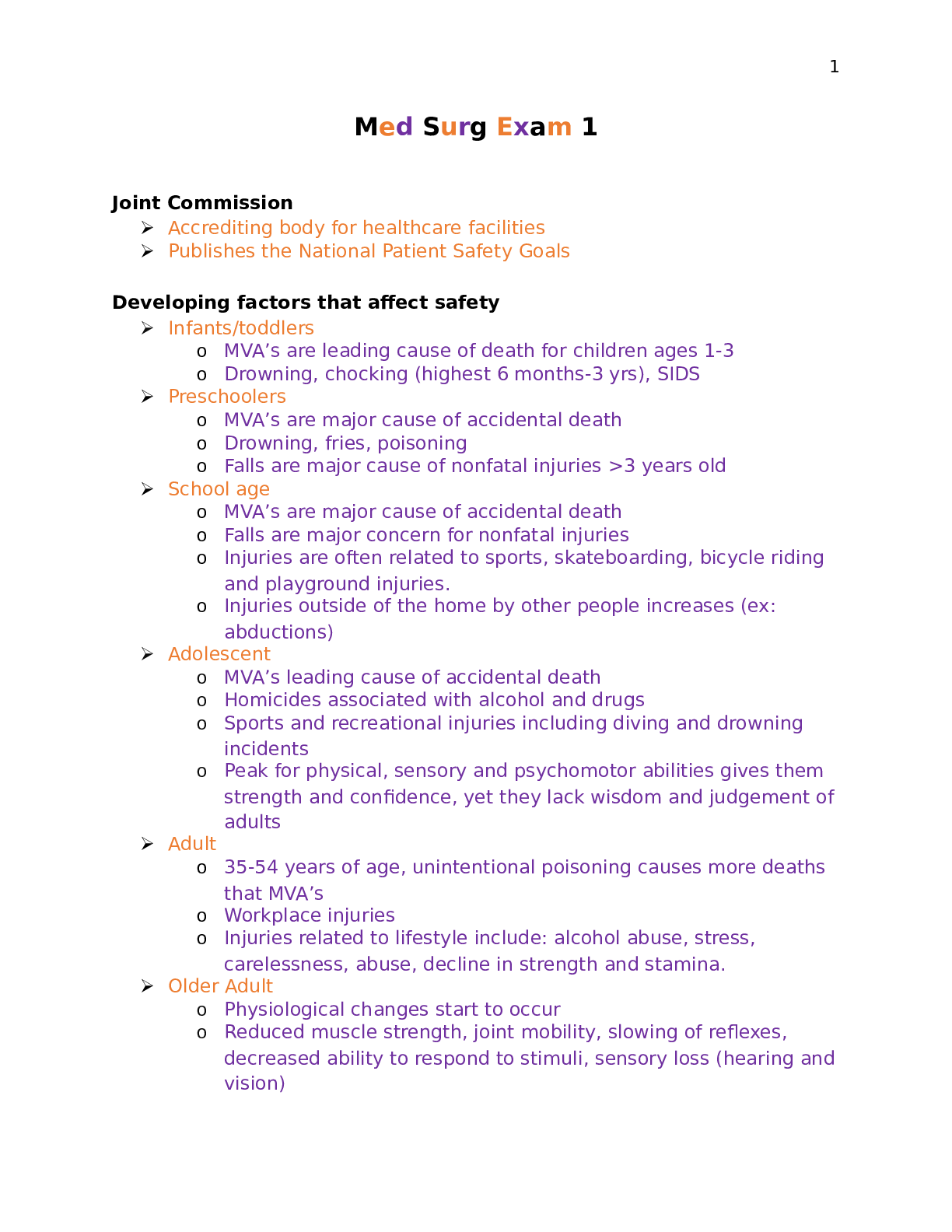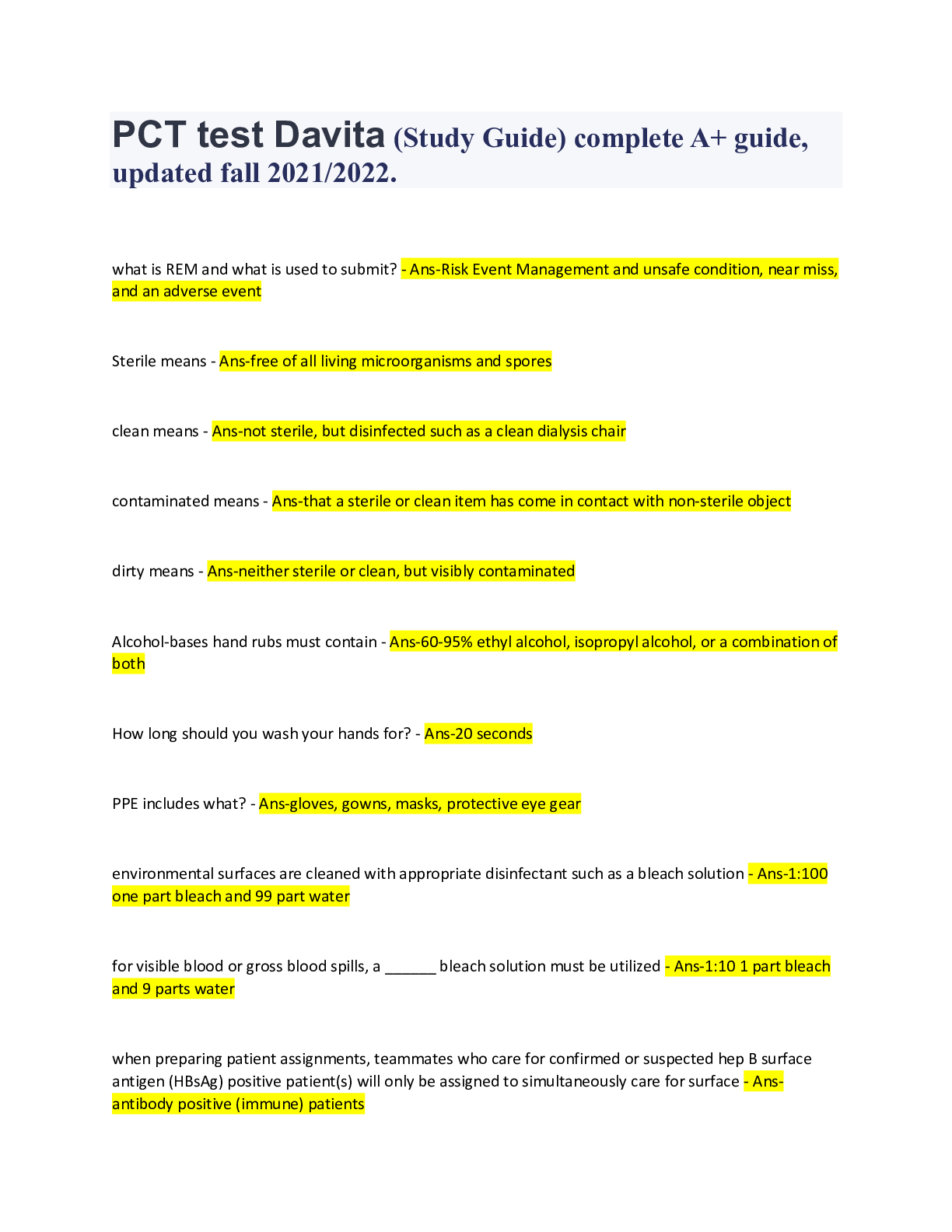Information Technology > QUESTIONS & ANSWERS > Questions Answers and Case Guides E-Commerce 100% A+ Guide, Download Now!! (All)
Questions Answers and Case Guides E-Commerce 100% A+ Guide, Download Now!!
Document Content and Description Below
1) Confidentiality is sometimes confused with: 1. A) privacy. 2. B) authenticity. 3. C) integrity. 4. D) nonrepudiation. Answer: A Difficulty: Easy AACSB: Application of knowledge LO: 5.1: Und... erstand the scope of e-commerce crime and security problems, the key dimensions of e-commerce security, and the tension between security and other values. 2) ________ refers to the ability to ensure that e-commerce participants do not deny their online actions. 1. A) Nonrepudiation 2. B) Authenticity 3. C) Availability 4. D) Integrity Answer: A Difficulty: Moderate AACSB: Information technology LO: 5.1: Understand the scope of e-commerce crime and security problems, the key dimensions of e-commerce security, and the tension between security and other values. 3) ________ refers to the ability to identify the person or entity with whom you are dealing on the Internet. 1. A) Nonrepudiation 2. B) Authenticity 3. C) Availability 4. D) Integrity Answer: B Difficulty: Moderate AACSB: Information technology LO: 5.1: Understand the scope of e-commerce crime and security problems, the key dimensions of e-commerce security, and the tension between security and other values. 4) Which of the following is an example of an integrity violation of e-commerce security? 1. A) A Web site is not actually operated by the entity the customer believes it to be. 2. B) A merchant uses customer information in a manner not intended by the customer. 3. C) A customer denies that he or she is the person who placed the order. 4. D) An unauthorized person intercepts an online communication and changes its contents. Answer: D Difficulty: Moderate AACSB: Analytical thinking LO: 5.1: Understand the scope of e-commerce crime and security problems, the key dimensions of e-commerce security, and the tension between security and other values. 5) ________ refers to the ability to ensure that an e-commerce site continues to function as intended. 1. A) Nonrepudiation 2. B) Authenticity 3. C) Availability 4. D) Integrity Answer: C Difficulty: Moderate AACSB: Information technology LO: 5.1: Understand the scope of e-commerce crime and security problems, the key dimensions of e-commerce security, and the tension between security and other values. 6) Which of the following is an example of an online privacy violation? 1. A) your e-mail being read by a hacker 2. B) your online purchasing history being sold to other merchants without your consent 3. C) your computer being used as part of a botnet 4. D) your e-mail being altered by a hacker Answer: B Difficulty: Moderate AACSB: Analytical thinking LO: 5.1: Understand the scope of e-commerce crime and security problems, the key dimensions of e-commerce security, and the tension between security and other values. 7) ________ refers to the ability to ensure that messages and data are only available to those authorized to view them. 1. A) Confidentiality 2. B) Integrity 3. C) Privacy 4. D) Availability Answer: A Difficulty: Moderate AACSB: Information technology LO: 5.1: Understand the scope of ecommerce crime and security problems, the key dimensions of ecommerce security, and the tension between security and other values. 8) Typically, the more security measures added to an ecommerce site, the faster and easier it becomes to use. Answer: FALSE Difficulty: Moderate AACSB: Information technology LO: 5.1: Understand the scope of ecommerce crime and security problems, the key dimensions of ecommerce security, and the tension between security and other values. 9) Why is it difficult to accurately estimate the actual amount of cybercrime? Answer: It is difficult to accurately estimate the actual amount of cybercrime in part because many companies are hesitant to report it due to the fear of losing the trust of their customers, and because even if crime is reported, it may be difficult to quantify the actual dollar amount of the loss. Difficulty: Moderate AACSB: Analytical thinking; Written and oral communication LO: 5.1: Understand the scope of ecommerce crime and security problems, the key dimensions of ecommerce security, and the tension between security and other values. 10) All of the following experienced highprofile data breaches in 2014 except: 1. A) eBay. 2. B) Home Depot. 3. C) Amazon. 4. D) Sony. Answer: C Difficulty: Moderate AACSB: Application of knowledge LO: 5.2: Identify the key security threats in the ecommerce environment. 11) Bitcoins are an example of: 1. A) digital cash. 2. B) virtual currency. 3. C) a stored value payment system. 4. D) an EBPP system. Answer: A Difficulty: Moderate AACSB: Information technology LO: 5.2: Identify the key security threats in the ecommerce environment. 12) The overall rate of online credit card fraud is ________ of all online card transactions. 1. A) less than 1% 2. B) around 5% 3. C) around 10% 4. D) around 15% Answer: A Difficulty: Difficult AACSB: Information technology LO: 5.2: Identify the key security threats in the ecommerce environment. 13) Which of the following has the Internet Advertising Bureau urged advertisers to abandon? 1. A) HTML 2. B) HTML5 3. C) Adobe Flash 4. D) Adobe Acrobat Answer: C Difficulty: Moderate AACSB: Information technology LO: 5.2: Identify the key security threats in the ecommerce environment. 14) Accessing data without authorization on Dropbox is an example of which of the following? 1. A) social network security issue 2. B) cloud security issue 3. C) mobile platform security issue 4. D) sniffing Answer: B Difficulty: Moderate AACSB: Information technology LO: 5.2: Identify the key security threats in the ecommerce environment. 15) All of the following are prominent hacktivist groups except: 1. A) Anonymous. 2. B) LulzSec. 3. C) Impact Team. 4. D) Avid Life. Answer: D Difficulty: Moderate AACSB: Information technology LO: 5.2: Identify the key security threats in the ecommerce environment. 16) Slammer is an example of which of the following? 1. A) virus 2. B) worm 3. C) Trojan horse 4. D) botnet Answer: B Difficulty: Moderate AACSB: Information technology LO: 5.2: Identify the key security threats in the ecommerce environment. 17) Which of the following is the leading cause of data breaches? 1. A) theft of a computer 2. B) accidental disclosures 3. C) hackers 4. D) DDoS attacks Answer: C Difficulty: Moderate AACSB: Information technology LO: 5.2: Identify the key security threats in the ecommerce environment. 18) Software that is used to obtain private user information such as a user's keystrokes or copies of email is referred to as: 1. A) spyware. 2. B) a backdoor. 3. C) browser parasite. 4. D) adware. Answer: A Difficulty: Moderate AACSB: Information technology LO: 5.2: Identify the key security threats in the ecommerce environment. 19) In 2014, Sony experienced which of the following? 1. A) a highprofile data breach 2. B) a DDoS attack that shut down its Web site 3. C) a hacktivist attack to protest its employment policies 4. D) a browser parasite Answer: A Difficulty: Easy AACSB: Information technology LO: 5.2: Identify the key security threats in the ecommerce environment. 20) What is the most frequent cause of stolen credit cards and card information today? 1. A) lost cards 2. B) the hacking and looting of corporate servers storing credit card information 3. C) sniffing programs 4. D) phishing attacks Answer: B Difficulty: Moderate AACSB: Information technology LO: 5.2: Identify the key security threats in the ecommerce environment. 21) Which dimension(s) of security is spoofing a threat to? 1. A) integrity 2. B) availability 3. C) integrity and authenticity 4. D) availability and integrity Answer: C Difficulty: Difficult AACSB: Analytical thinking LO: 5.2: Identify the key security threats in the ecommerce environment. 22) Which of the following is not an example of malicious code? 1. A) scareware 2. B) Trojan horse 3. C) bot 4. D) sniffer Answer: D Difficulty: Moderate AACSB: Information technology LO: 5.2: Identify the key security threats in the ecommerce environment. 23) Zeus is an example of which of the following? 1. A) SQL injection attack 2. B) browser parasite 3. C) DDoS attack 4. D) Trojan horse/botnet Answer: D Difficulty: Moderate AACSB: Information technology LO: 5.2: Identify the key security threats in the ecommerce environment. 24) Rustock is an example of which of the following? 1. A) worm 2. B) botnet 3. C) phishing 4. D) hacktivism Answer: B Difficulty: Moderate AACSB: Information technology LO: 5.2: Identify the key security threats in the ecommerce environment. 25) Malware that comes with a downloaded file that a user requests is called a: 1. A) Trojan horse. 2. B) backdoor. 3. C) driveby download. 4. D) PUP. Answer: C Difficulty: Moderate AACSB: Information technology LO: 5.2: Identify the key security threats in the ecommerce environment. 26) Which of the following is not an example of a PUP? 1. A) adware 2. B) browser parasite 3. C) driveby download 4. D) spyware Answer: C Difficulty: Difficult AACSB: Information technology LO: 5.2: Identify the key security threats in the ecommerce environment. 27) Which of the following was designed to cripple Iranian nuclear centrifuges? 1. A) Stuxnet 2. B) Flame 3. C) Snake 4. D) Storm Answer: A Difficulty: Moderate AACSB: Information technology LO: 5.2: Identify the key security threats in the ecommerce environment. 28) Automatically redirecting a Web link to a different address is an example of which of the following? 1. A) sniffing 2. B) social engineering 3. C) pharming 4. D) DDoS attack Answer: C Difficulty: Moderate AACSB: Information technology LO: 5.2: Identify the key security threats in the ecommerce environment. 29) FREAK is an example of which of the following? 1. A) mobile malware 2. B) software vulnerability 3. C) botnet 4. D) Trojan horse Answer: B Difficulty: Moderate AACSB: Information technology LO: 5.2: Identify the key security threats in the ecommerce environment. 30) According to Ponemon Institute's 2015 survey, which of the following was not among the causes of the most costly cybercrimes? 1. A) malicious insiders 2. B) malicious code 3. C) denial of service 4. D) botnets [Show More]
Last updated: 1 year ago
Preview 1 out of 44 pages
.png)
Buy this document to get the full access instantly
Instant Download Access after purchase
Add to cartInstant download
We Accept:

Reviews( 0 )
$8.00
Document information
Connected school, study & course
About the document
Uploaded On
Jul 23, 2021
Number of pages
44
Written in
Additional information
This document has been written for:
Uploaded
Jul 23, 2021
Downloads
0
Views
78

.png)
.png)
.png)
.png)
.png)
.png)
.png)
.png)
.png)
.png)
.png)

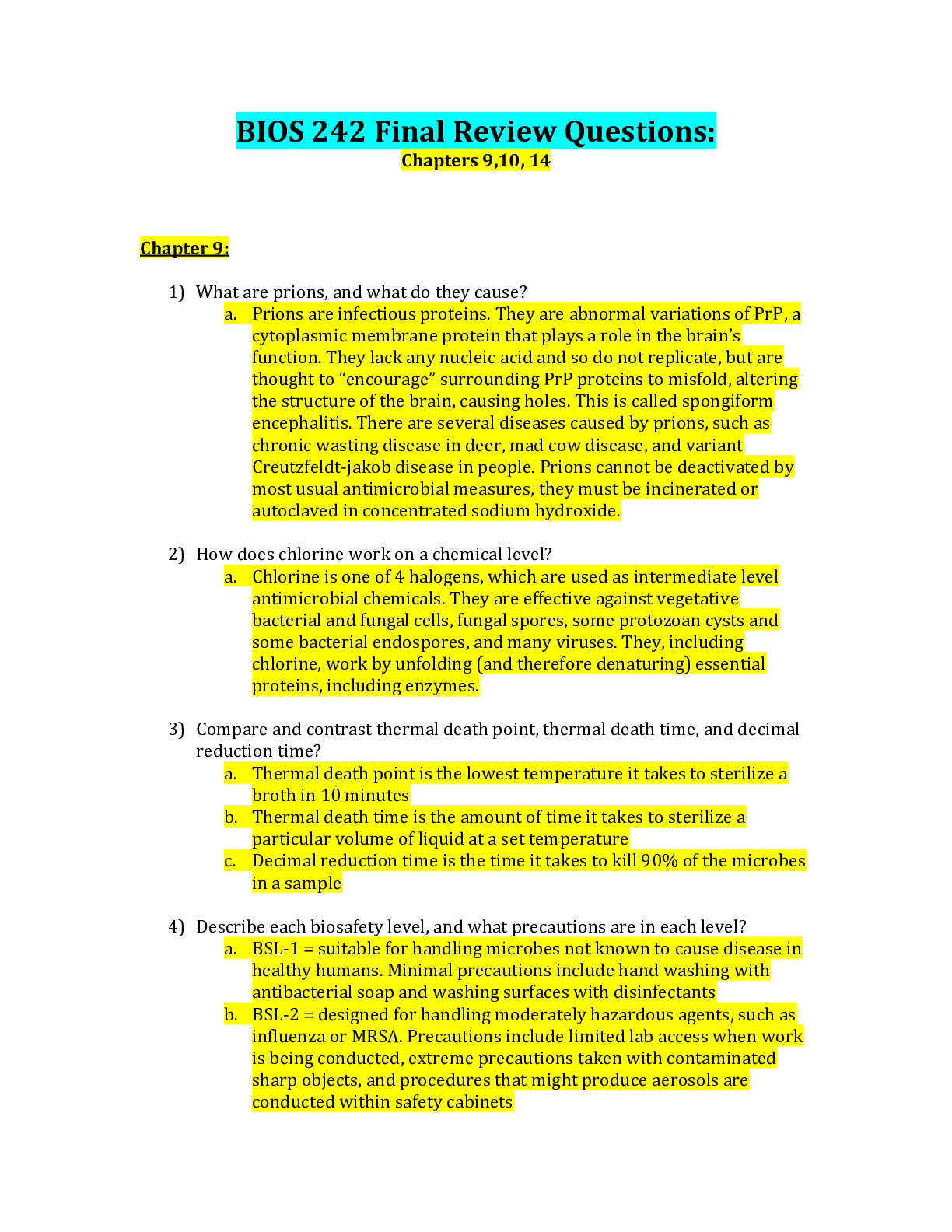
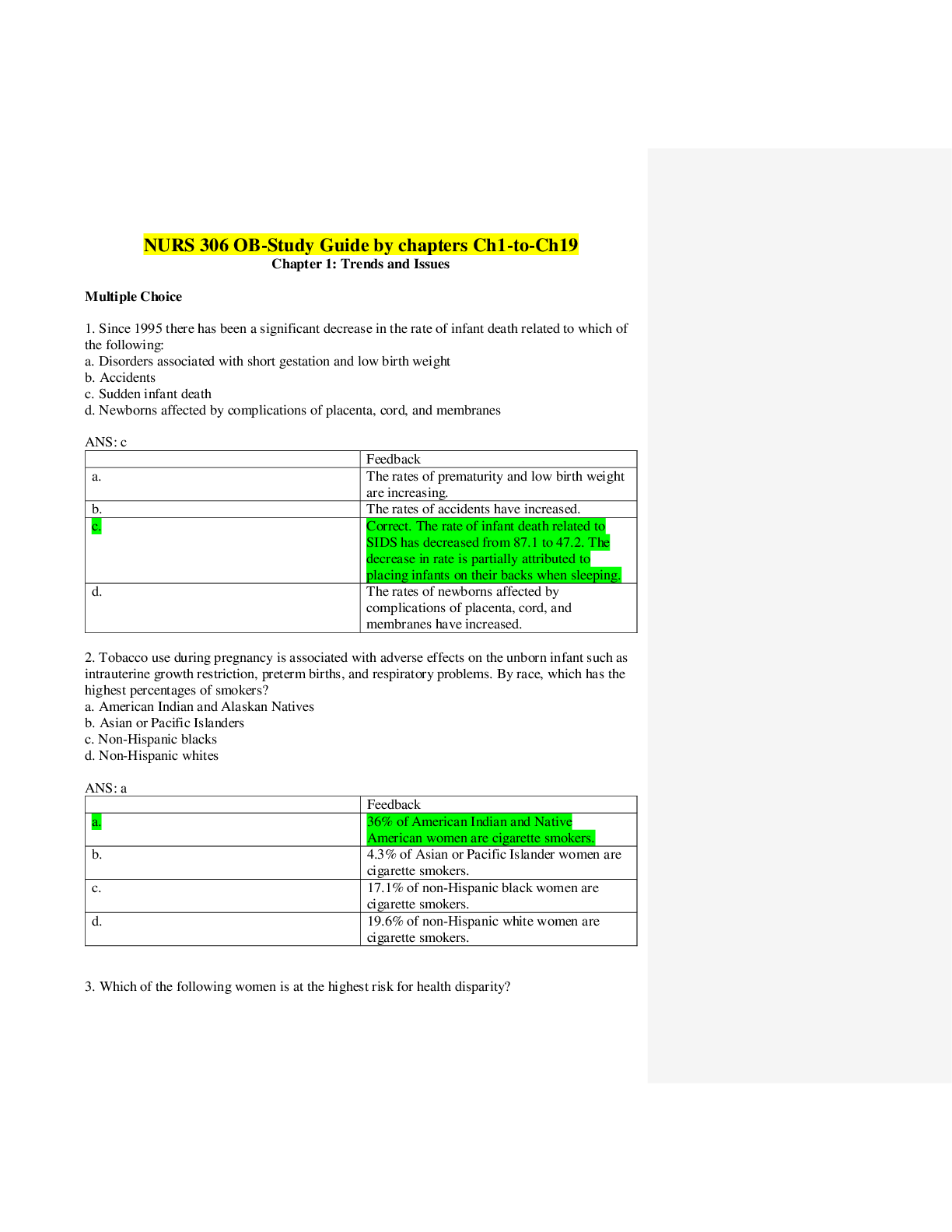

.png)
